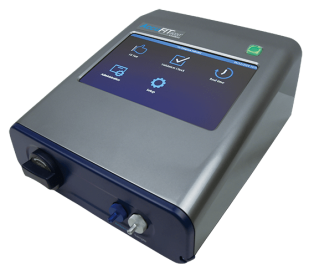
Mask tightness tester
Tightness is an important indicator for evaluating the protective performance of masks. Ordinary users often only focus on common issues such as the protective properties of masks against particulate matter, while neglecting the individual issue of whether the mask matches the user. Even if factors such as product characteristics and usage environment are considered, dust masks may weaken their protective effect due to being unsuitable for the user.
Therefore, the tightness testing of dust masks is a necessary step in evaluating dust masks. When consumers purchase dust masks in their daily lives, they need to consider the performance of the product comprehensively from all aspects in order to effectively maximize the effectiveness of dust masks.
The tightness of a mask is usually expressed as the total leakage rate, which is the ratio of the concentration of the simulated agent that leaks into the mask from all mask components, including filtering elements, when the subject inhales under laboratory specified testing conditions, to the percentage of the simulated agent concentration in the inhaled air. The lower the total leakage rate, the higher the tightness.
Introduction:
The quantitative fit test of coordinated movements can be used as a method to select a mask that fits one's face. In the tightness testing mode, follow the pre-set actions, measure in order, and display the test results of each action and the comprehensive measurement results of all actions.
Definition:
A device that measures the dust concentration on the outer and inner sides of a mask, and calculates the intrusion rate (leakage rate%) of dust inside the mask based on the results. The experimental particles use general dust suspended indoors. When measuring the dust on the inside of a mask, use a test guide or a fitting kit.
Applicable scope:
There is no other tightness tester that can quantitatively test the tightness of all types of respirators. This tightness tester can perform tightness testing on gas masks, SCBAs respirators, and other types of respirators.
Research on Inspection, Training, and Teaching of the Tightness of Mask Wearing
Performance evaluation of respiratory protective masks (PAPRs)
Sealing test for self-contained breathing apparatus
Gas mask sealing test
Features:
1. Use one detector (particle counter) to automatically switch and continuously measure the particle count indoors (on the outside of the mask) and inside the mask. This can reduce errors caused by differences in detector characteristics.
2. Provide three modes: tightness testing mode, tightness checking mode, and practice mode, which can be distinguished and used according to various purposes.
3. The test guide piece can be used separately for measurement (without damaging the mask) or the pipe joint kit can be used for measurement (with holes on the mask).
4. Equipped with heating tubes to prevent condensation of water vapor during exhalation and the formation of water droplets.
5. Equipped with RS-232C output function to output measurement data.
6. The wearing condition of the mask can be confirmed through a dedicated mirror.
Product features:
1. Easy to operate and use
2. Independent operation type - no need for external computer connection
3. Optional mask sample adapter allows for testing the tightness of various masks
4. Color touch screen can be operated with fingers or pens
5. FitPro+TM tightness testing software can automatically complete testing
6. External computer can generate reports and print tightness test cards
7. The tightness coefficient is greater than 10000
8. Using micro particles in ambient air to calculate mask fit factor
9. Provide interactive training tools for initial and subsequent training
Technical parameters:
Measurement object: Evaluation of the tightness between the mask and the face
Measurement items: Number of particles and leakage rate, protection coefficient
Measurement principle: Particle number concentration based on laser scattering method (determination of particle number ratio of indoor dust and dust inside masks)
Object particle size: from 0.3 μ Above m, 0.5 μ Above m, 0.3-0.5 μ Select from m
Measurement range: Counting range: 0-9999999 Counting, Leakage rate: 0-100%, Protection coefficient: 1-10000
Measurement accuracy: 5% (when the particle number concentration is 100000 pieces/L)
Measurement time: The standard measurement time is 10 seconds for each purification on the outside and 3 seconds for each measurement inside the mask (a total of approximately 26 seconds)
Extraction flow rate: 1 L/min
Internal functions: leakage rate and protection coefficient calculation function, heating tube temperature adjustment function, drying function, RS-232C output function
Usage environment: 0-40 ℃, 30-90% rh (non condensation)
Main protective device: fuse tube (for AC250V) φ 5.2 x 20 mm, 3.15A)
Power supply: AC100~240V, 50/60Hz, approximately 0.5 A
Main dimensions and mass: 210 (W) x 240 (D) x 232 (H) mm (excluding protrusions), approximately 3 kg
Technical features:
1. Easy to operate and convenient to use;
2. Independent operation type, no need for external computer connection;
3. Optional mask sampling adapter, allowing for testing the tightness of various masks;
4. The color touch screen can be operated with fingers or pens;
5. FitPro+TM tightness testing software, which can automatically complete testing;
6. External computers can generate reports and print tightness test cards;
7. Calculate the mask fit factor using micro particles in the ambient air;
8. Provide interactive training tools for initial and subsequent training.
Prev: Mask melt blown cloth virus filtration efficiency tester